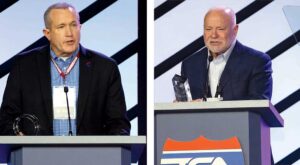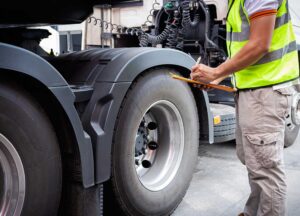Love ’em or hate ’em, electronic logging devices (ELDs) are here to stay for the majority of drivers of commercial vehicles. Once ELDs became mandatory (for most drivers) in December 2017, tracking and reporting of drivers’ hours of service (HOS) was changed forever.
Those changes began in the U.S. Legislature with the passage of a 2012 transportation funding bill known as Moving Ahead for Progress in the 21st Century Act, or MAP-21.
A portion of that bill was the Commercial Motor Vehicle Safety Enhancement Act, which mandated the ELD rule. As directed, the Federal Motor Carrier Safety Administration (FMCSA) issued the final rule in December 2015, and the rule was fully enacted four years later.
Drivers are still required to fill out paper logs if their ELD system isn’t working or when driving vehicles that aren’t ELD equipped, or if they have ELD systems that can’t accept data from the system in a previously driven truck. There is a limit of eight days of operation unless the truck or the work is exempted.
Another issue is that drivers can come to depend on warnings and alerts from the ELD rather than mentally tracking their hours. Those drivers may need a refresher on the hours-of-service rules when paper logs are used.
The basics haven’t changed much in a decade or more. Drivers of property-carrying vehicles can’t drive after 11 hours of driving or after 14 hours of combined driving and working (on-duty, not driving).
There are exceptions to both rules, such as additional time allowed if the driver encounters adverse driving conditions that could not have been reasonably known at the beginning of the shift or trip.
The driver must take a 30-minute break before or at the eight-hour driving mark. Thanks to a September 2020 change to the rule, the break can be used for non-driving activities such as fueling or inspections, as long as no driving is done. Before this change, the driver had to log off-duty, sleeper berth or a combination of the two for the break.
Drivers can’t drive after 60 hours of driving or working in a seven-day period, or after 70-hours in an eight-day period. The 70-hour rule is typically used for trucking operations that run seven days a week, while the 60-hour rule is used by operations that regularly shut down on specific days each week, such as weekends. When the limits are reached, drivers must wait until the hours fall under the limit or take a 34-hour restart to reset those hours at zero before driving again.
It’s important to note that the 14-hour rule and the 60 in seven and 70 in eight rules do not prohibit working beyond the set limits. The rules prohibit driving until the requirements are met, but non-driving work such as loading or unloading aren’t restricted. Drivers can work as many hours as they like, as long as no driving is done until the driver has had 10 hours off-duty or in the sleeper berth or the total hours fall below 60 or 70, depending on the rule used.
The adverse weather provision is often misunderstood and misused. In order for a driver to drive extra hours under the rule, the circumstances causing the adverse conditions cannot have been reasonably known before the driving period began.
For example, predicted rain can result in flooding over the roadway, or in certain conditions can quickly turn to snow and ice. An argument that those conditions could not have been reasonably known might be a solid one. However, if weather reports predicted freezing precipitation for several days, it becomes harder to argue that the driver couldn’t have known the roads would be bad.
In another example, a traffic jam caused by an accident can’t be known beforehand — but claiming adverse driving conditions because of rush hour in a large city might not work as well.
There are also specific regulations that govern ELDs. The first is that the device used must be registered with the FMCSA. That’s a process that begins with the manufacturer following the necessary registration steps, including a “self-certification” that the ELD meets all the requirements.
The carrier must verify that the device is registered; if the carrier is a one-truck owner-operator business, the owner/driver has the responsibility. Registration can be done online at eld.fmcsa.dot.gov/list. The page includes a list of more than 800 registered devices and also includes a link to a list of devices for which the registration has been revoked.
Also, it’s helpful to make sure the most current version of the ELD software is being used. Check with the manufacturer for updates.
There may be a current problem with ELDs that depend on cellular networks to transmit data. The 3G network has been retired by every major carrier except Verizon, and even that one will be retired in December. Owners of ELDs that depend on the Verizon network should make sure their devices will operate on 4G or 5G networks.
Smaller cellphone carriers such as Cricket, Pure Talk or Consumer Cellular contract to use the networks of larger carriers, so a phone-based ELD that works through another carrier could still use the Verizon network.
There are rules that govern ELD capabilities, too. The device must be able to transfer the driver’s record-of-duty status (RODS) electronically to an inspector during a stop, confirm successful transmission and allow the safety official to enter a comment.
During an inspection, some officials will be satisfied with looking at the driver’s record on the screen of the ELD, but many will want either a printout or a copy of the record. This can be accomplished in several ways. The safety official can connect via Wi-Fi or Bluetooth, or the ELD system can transmit via fax or email. Another option is to record the data on a thumb drive that the official inserts into his or her own device.
Instructions for operating the ELD, and for transmitting data must be carried by the driver and provided to the safety officer on demand. Often, written instructions are included in the ELD program so that it isn’t necessary to carry printed materials.
Knowing the provisions of the HOS rules and the workings of the ELD that records them is a vital part of any driver’s job.
Cliff Abbott is an experienced commercial vehicle driver and owner-operator who still holds a CDL in his home state of Alabama. In nearly 40 years in trucking, he’s been an instructor and trainer and has managed safety and recruiting operations for several carriers. Having never lost his love of the road, Cliff has written a book and hundreds of songs and has been writing for The Trucker for more than a decade.








